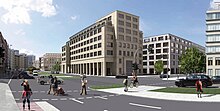Köllnisches Rathaus

The striking building of the Köllnisches Rathaus was - built as the seat of the city council assembly of the cities of Kölln and Berlin , which merged in 1709 - from 1723 to 1900 part of the city administration of Berlin.
Location and surroundings
The area of the former Köllnisches Rathaus is located on today's corner of Breite Straße and Gertraudenstraße . The main facade of the building faced the (now defunct) Köllnischer Fischmarkt, today it belongs to the ramp of the Mühlendamm Bridge .
history
It is unclear where the original town hall of the town of Kölln, which was built in the 12th century, was located. Historians and archaeologists suspect a location near Petriplatz , probably even in the same place as the Kölln town hall from the baroque period . However, no reliable evidence was found for this in the excavations in 2010 either, only about “renovations” of the town hall in 1580 and 1583 in early modern documents, in 1612 about a new building after a partial collapse.
After the unification of the cities of Berlin and Kölln (as well as Friedrichswerder , Dorotheen- and Friedrichstadt ) to form the capital and residence city of Berlin in 1709, King Friedrich I ordered the construction of a new town hall at the Köllnischer Fischmarkt. The rooms of the Berlin Old Town Hall had become too small to accommodate the administration, so the new town hall was to be the seat of the city council. The design was made by court architect Martin Grünberg , and he is said to have had the Amsterdam City Hall in mind when he designed it.
The death of Friedrich I and the assumption of government of Friedrich Wilhelm I, known as extremely economical (with the exception of military spending) in 1713 (the soldier king), called the entire project into question. Although the construction was completed, the tower originally planned by Grünberg was saved, as was a stately open staircase in front of the main portal for cost reasons.
Also, after the completion of the stunted building in 1723 , the city council did not meet in Kölln, but continued in Berlin's Old Town Hall until 1822 ; but only until the construction of the Red Town Hall (1860–1869) by Hermann Friedrich Waesemann . After the fire in the Petrikirche in 1730, which also destroyed a number of surrounding buildings, the teaching of the heavily damaged Köllnisches Gymnasium was temporarily housed in the Köllnisches Rathaus. The provisional lasted until 1868 necessary road widening was established, the Märkisches Museum resided in the town hall building at the Köllnischer Fischmarkt .
After the town hall was demolished, a commercial building was built on the property as part of the tertiaryisation of the town center in 1910. The block on the opposite side had already been covered with department store buildings at the end of the 19th century . The building was badly damaged in World War II and finally demolished in the 1950s, also in order to build and widen the new traffic axis Grunerstraße - Leipziger Straße.
The inner city plan approved by the Berlin Senate in 1999 provided for a critical reconstruction of the Cöllnisches Rathaus. Its cubature should be modeled. The planners also consider six floors to be compatible (eight in the tower stub). On the Petriplatz side , the Köllnische Ratswaage is to be reconstructed or modeled on the foundations found during archaeological excavations.
future
The area of the town hall, which is a ground monument, was used in 2011 to set up the construction site for the demolition work for the GDR Ministry of Construction in Scharrenstrasse. In the summer of 2011, the building plan I-218 was approved by the Berlin House of Representatives . The area was sold by the State of Berlin to Hochtief in 2012 , which announced a competition for the construction of a commercial building that was won by the Ortner und Ortner architecture firm (Berlin / Vienna) in February 2013. A hotel is to be built there. [outdated]
Individual evidence
- ^ A b Herbert Schwenk: Laying of the foundation stone for a new town hall . In: Berlin monthly magazine ( Luisenstädtischer Bildungsverein ) . Issue 8, 1999, ISSN 0944-5560 , p. 83-86 ( luise-berlin.de ).
- ^ Association for the history of Berlin (ed.): Chronicle of the Cöllner Stadtschreiber from 1542–1605. Berlin 1865.
- ^ Manfred Funke: The town hall on the Cölln fish market. In: Communications from the Association for the History of Berlin. Issue 2, April 2009.
- ^ Benedikt Goebel: The conversion of old Berlin to the modern city center. Publishing house Braun, Berlin 2003.
- ^ The beginnings of Cölln and Berlin . ( Memento of the original from March 4, 2016 in the Internet Archive ; PDF; 2.2 MB) Info: The archive link was inserted automatically and has not yet been checked. Please check the original and archive link according to the instructions and then remove this notice. Senate Department for Urban Development
- ↑ At the archeology center the costs explode. In: Der Tagesspiegel , June 23, 2015
Coordinates: 52 ° 30 ′ 50.9 ″ N , 13 ° 24 ′ 19.3 ″ E


